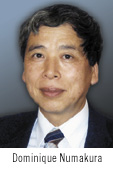
Japan’s leading-edge technology attracts big crowds.
The 36th InterNepcon, Japan’s largest exhibition for technology and equipment related to electronics manufacturing, was held at Tokyo Big Sight January 17-19. The show has expanded over the last several years, and more than 950 companies and organizations spread their booths over two floors. The floor plan was so cramped that some major companies were unable to rent booth space this year. Floor space was at a premium, and there was no extra room available to use for meeting space or demonstrations. Reed Exhibition announced that another floor would be added next year to provide enough space for all the companies.
Nowadays, Japan is not the predominant figure in the electronics industry from a manufacturing standpoint; however, Japanese companies are the leaders in technology, and the exhibition still attracts engineers from around the world. Special zones were set up for soldering, mounting machines, image processing, EMS/ODM and plating/etching, to name a few. Each zone contained booths for dozens of leading companies in each specialty.
Three days were not enough to see all of the exhibitions. I estimate more than one hundred thousand people visited the show during the three day exhibition. The narrow aisles and limited booth spaces were jammed with aggressive engineers pitching their products. The more popular booths were crowded with visitors. Exhibition time was extended to 6:00 p.m., but the crowds still did not subside by closing time.
There were not many multilayer board manufacturers or flexible circuit manufacturers represented at the exhibition. You could see an industry trend towards finer traces, smaller via holes and higher circuit densities though. Mechanical drilling of 100-micron diameter via holes (4 mils) was very common for board manufacturers. Many companies exhibiting said they are able to generate via holes smaller than 40 microns in diameter (1.6 mils) using UV YAG laser, making a 30-micron pitch trace (1.2 mils) common for both rigid boards and flexible circuits. Several flexible circuit manufacturers displayed ultra high-density circuits. Nitto Denko, one of the major flexible circuit manufacturers in Japan, showed 20-micron pitch traces (0.8 mils) built by a roll-to-roll manufacturing process. An engineer explained that it was made by a semi-additive process, and said it is ready for volume production. Taiyo Industrial, a prototype shop for flexible circuits, displayed several flexible samples with 15- to 17-micron pitch traces.
One category that was a hit at the show was ultra-fine screen-printing. There were many screen suppliers pitching its low cost capabilities as the alternative solution to traditional lithography or direct imaging process. Machine manufacturers for the screen-printing segment presented capabilities smaller than 20-micron pitches. Equipment manufacturer MicroTech said it could provide roll-to-roll machines for 20-micron pitch lines. Most of the screen mask suppliers displayed high-resolution capabilities; 30-micron pitch was the minimum. Naganuma Art Screen demonstrated 15-micron pitch resolution (3-micron lines and 11-micron spaces).
Ink material, an issue that arises from screen-printing, was also discussed at the show. Many manufacturers said it is relatively easy to have fine conductive ink material generate 10-micron lines and spaces for the green sheet of multi-layer ceramic circuits. Another challenge is to get conductive paste for fine line printing. A couple of material suppliers said their nanopastes could be the solution; however, no nanopaste could satisfy all of the basic requirements such as conductivity, resolution and bond strength on the substrates. Another big hurdle for nanopaste to overcome is cost related. Customers are expecting a remarkable cut in costs by screen-printing processes; therefore, the circuit manufacturers and end customers are looking for a suitable conductive ink material that has a competitive cost position.
Headlines
Panasonic developed a third generation negative electrode for lithium ion batteries. It improves energy density 20% from the second-generation electrode.
Japanese equipment manufacturer Howa Kogyo has developed a new alignment system with an accuracy of +/-10 microns for multi-layer ceramic circuit boards.
Sony unveiled a new flat panel TV with a 27? OLED panel. The company believes OLED could be the main future technology of flat panel displays instead of LCD. The company also rolled out a new AOI machine with microscope function for SMT circuit boards.
Sharp will build a second plant in Mexico for the complete manufacturing of flat panel TVs. Also, the company unveiled the world’s largest (108?) LCD HDTV utilizing the capabilities of its new Kameyama Plant.
Kuraray, a plastic supplier in Japan, will invest 4 billion yen to increase manufacturing capacity of polyvinyl alcohol films for LCD panels.
Japanese PCB manufacturer KFE agreed to a business alliance with In-Flow for Internet sales of large volume PCBs.
IDEC, a device manufacturer in Japan, has commercialized a thin panel switch (3.2 mm thick) for control panels of industrial equipment.
Major disc drive manufacturers Hitachi GST, Samsung Electronics, Seagate, Toshiba and Fujitsu have organized “Hybrid Storage Alliance†to expand the applications of hybrid disc drive systems for notebook personal computers.
In addition, Toshiba will commercialize an SDHC memory card (4 GB), mini SDHC memory card (4 GB) and micro SD memory card (2 GB) for portable electronics. The company has also developed the world’s first hybrid memory system for hard disc drives and DVDs in desktop PC applications. PCD&M
Dominique Numakura is president of DKN Research; This email address is being protected from spambots. You need JavaScript enabled to view it..














